Historical Markers Explained
Point Bolivar Historical Marker: On the grounds of the lighthouse [not accessible by the public]
Headquarters for Long’s expedition which attempted to free Texas from Spanish rule in 1819. Named in honor of Simon Bolivar (1783-1830) leader in the Spanish-American War for independence. Here Mrs. Long and a small group remained until news of her husband’s death came in 1822. A lighthouse was erected here by the Republic of Texas.
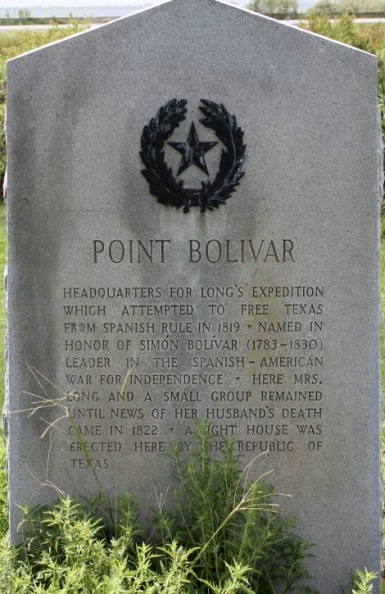
Fort Travis Historical Marker: On the grounds of Fort Travis Seashore Park
In early 1836, soon after Texas declared independence from Mexico, Republic of Texas President David Burnet dispatched Colonel Ed Harcourt to Galveston Island to erect a fort. Using army recruits and slave labor Harcourt built an octagonal earth and timber fortification armed with six and twelve-pound gun mounts appropriated from the Texas Navy vessel CAYUGA. Named Fort Travis in honor of William B. Travis, famous defender of the Alamo, it was located at the east end of the island. After high winds damaged the fort in 1837 the site was converted into a gun battery called Fort point, its present name.
In 1898-99, with the beginning of Federal development of the Port of Galveston, a second Fort Travis was established across Galveston Bay at Bolivar Point near the former site of a Civil War Confederate fortification called Fort Green. Two batteries, named Davis and Ernst, were completed in 1899 and a third, named Kimble, completed in 1922. Coastal defense facilities were added to the fort during World Wars I and II. Fort Travis was decommissioned and sold as war surplus in 1949. Besides its obvious military uses, Fort Travis also served as a refuge from hurricanes and as a Civil Defense shelter for area residents.
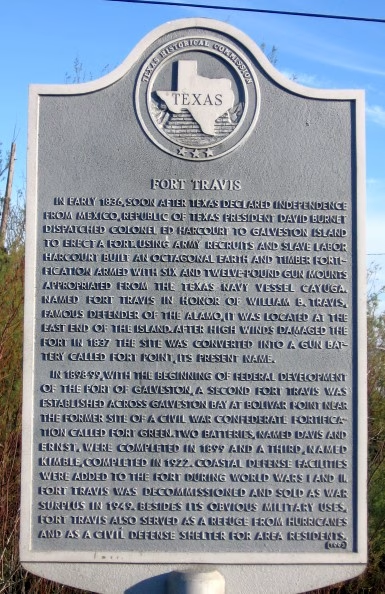
Bolivar Point Historical Marker: At the Jane Long Memorial near the entrance to Fort Travis
In 1815 Colonel Henry Perry established a military camp here as part of a plan to invade Spanish Texas. In 1816 Galveston-based privateer Louis-Michel de Aury forced shiploads of captured African Slaves to walk from this point to New Orleans along old Indian Trails. Aury is credited with naming the point after South American liberator Simon Bolivar.
While commanding a filibuster to win Texas independence, James Long established Fort Las Casas on Bolivar Point in 1820-21. His wife, Jane Herbert (Wilkinson), gave birth to a daughter, Mary James, in December 1821 at the fort. Mary James Long is often referred to as the first Anglo child born in Texas.
A lighthouse, erected here by the Federal government in 1852 and later dismantled by Confederate soldiers during the Civil War, was rebuilt after the war. Many area residents sought shelter within the lighthouse during the damaging storms of 1900 and 1915.
The Gulf and Interstate Railroad was completed from Beaumont to Bolivar Point in 1896. A boon to peninsula farmers, the railroad was destroyed in the 1900 storm, then rebuilt in 1903. Ferry service, purchased by the Texas Highway Department in 1933, continues to provide free public access to Galveston Island.
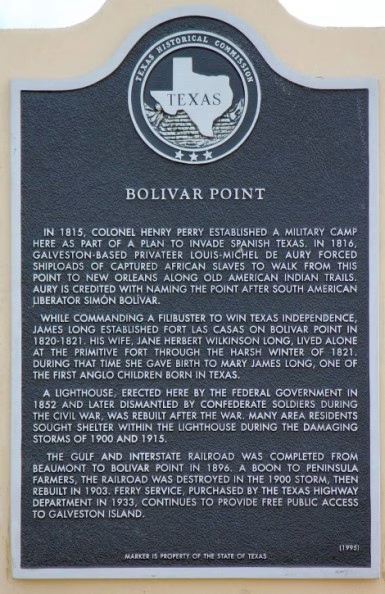
Jane Herbert Wilkinson Long Historical Marker: (July 23, 1798 – December 20, 1880) At the Jane Long Memorial near the entrance to Fort Travis
Born in Charles county, Maryland, Jane Herbert Wilkinson Long was a Texas pioneer. She married James Long in 1815, and joined him in Texas during his military invasion of the then-Spanish colony, settling in Nacogdoches. The occupation was unsuccessful, but the Longs returned with supporters in 1820, building a fort on the Bolivar peninsula at the eastern entrance to Galveston bay. James Long left for La Bahía to gain support, but was captured and imprisoned in Monterrey. Meanwhile, Jane, along with her daughter Ann and slave Kian, remained at the fort, facing frigid winter temperatures, lack of food and supplies, and danger from the native Karankawas. In the midst of these difficulties, Jane Long gave birth to a child, leading to her honorary designation as “Mother of Texas.”
After hearing of her husband’s death, Long led her family to settle at various places along the San Jacinto river and San Antonio. The family moved to be with kin in Louisiana and Mississippi in 1823, but returned in 1825 as part of Stephen F. Austin’s first colony, receiving her own headright of land, usually accorded only to a male head of household. She settled in San Felipe de Austin.
During the Texas war for independence, Long opened her boarding house for rallies and meetings, while also gathering information from Mexican officers and storing arms and munitions. She fled with others during the runaway scrape. After the war, in her remaining years, Long operated a boarding house and plantation in Fort Bend county. Today, Jane Herbert Wilkinson Long continues to be remembered as a Texas patriot and a pioneer of the Texas frontier.
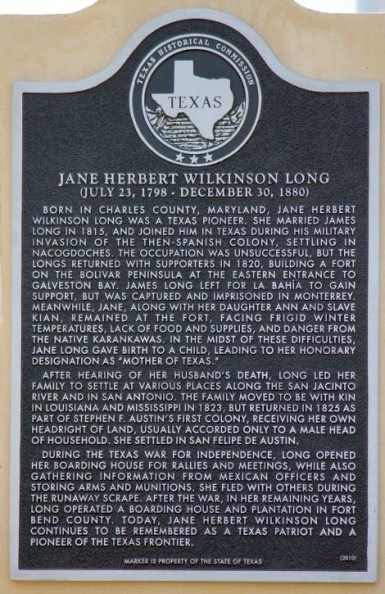
Point Bolivar Historical Marker: Marker relocated to the Port Bolivar Cemetery after Ike
Surveyor Samuel D. Parr claimed a league of land extending 5 miles eastward from Point Bolivar and in 1838 became the area’s first permanent settler. That year developers Archibald Wynn and William Lawrence purchased about 1000 acres of Parr’s land and surveyed a townsite named Ismail (Ishmael). When the first post office was established in 1876 the community’s name became Gabion. The community was renamed Port Bolivar in 1893.
In 1896 developers L.P. Featherstone and Fox Winnie constructed a railroad line connecting Point Bolivar to Galveston and Beaumont. Featherstone was instrumental in dredging a channel and building a wharf, where the first cargo ship landed in 1909. The town prospered and by 1911 contained a schoolhouse and a Methodist church. Business activity at the wharf continued to expand and Port Bolivar’s economy surged.
Shipping worldwide slowed at the outset of World War I and use of the wharf declined. In 1915 the town and wharf were severely damaged by a storm and many facilities were never rebuilt. The community turned to commercial fishing and tourism to successfully revitalize its economy. Regular ferry service to the mainland, which began in 1930, continues today.
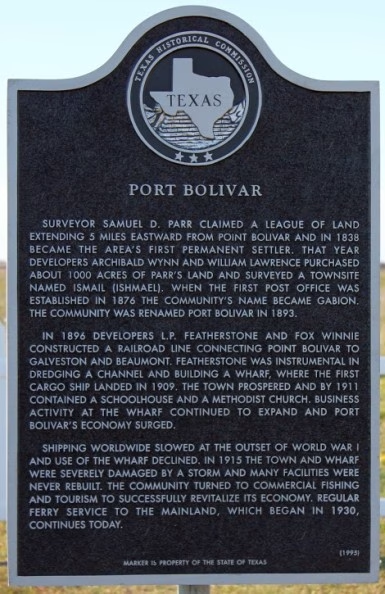
Port Bolivar Cemetery Historical Marker: On the grounds of the Port Bolivar Cemetery
Port Bolivar Cemetery was established between 1885 and 1890. There was seven recorded graves before 1900. They were the descendants of the Simpton’s, Schreiber’s, Clinton’s and Megg’s. In the early 1900 the recorded family graves are Johnson’s, Lindner’s, Langham and Shaw. There are dome unknown names for grave site located in the cemetery. In 1994 Jane Ewing located and record all graves. 1972 1.76 acres and in 1994 1.33 acres was donated by the Jeffery Family. In 2011 the Andrew Johnson Family donated 0.36 acres. The cemetery is free of charge for the residents of Port Bolivar and their families. The cemetery is maintained by donations and volunteers. For more information website search Find a Grave Port Bolivar Cemetery.
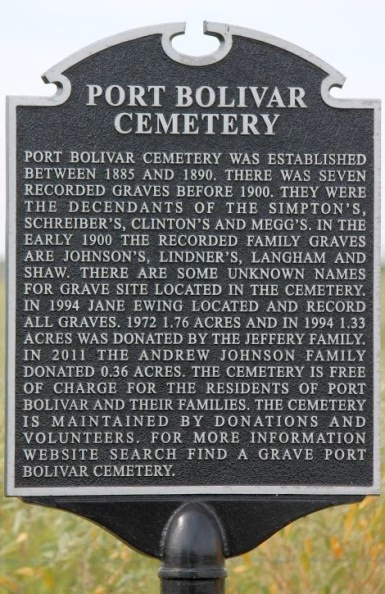
Crenshaw Family Cemetery Historical Marker: On the grounds Crenshaw School
Virginia Native and Civil War Veteran James A. Crenshaw wed Henrietta Barker Elliott in Kentucky in 1870. Two years later, with their first child, they moved to Bolivar Peninsula and constructed a two-story house in this vicinity. James, a successful farmer, transported his produce across the water to Galveston markets using his fleet of nine sailboats. The couple eventually had ten children; two young daughters died, one in 1875, the other in 1882, and the family buried them here in a grove of oak trees close to the house.
The family’s home survived the 1900 Galveston hurricane; after the storm, the J.A. Crenshaws left the Peninsula. Two sons remained, and daughter Helen Crenshaw wed Dr. Newell W. Atkinson in Edna, Texas, in 1907. The land containing the burial ground remained in family hands, but the iron fencing around the cemetery gradually disappeared except for a portion imbedded in a tree. In 2003, two descendants of Helen and Newell Atkinson donated land, including the burial ground, to the Galveston Independent School District, which maintains the historic cemetery as a link to early Bolivar settlers.
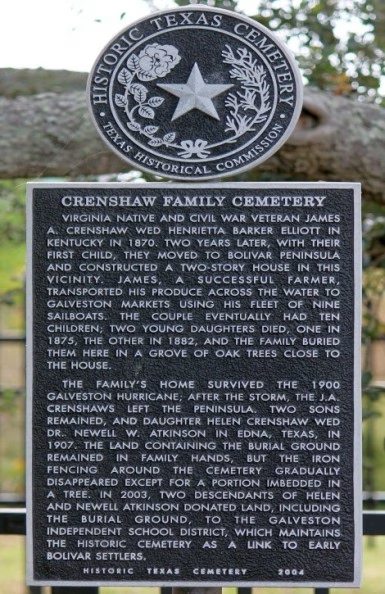
The Breakers Historical Marker: On Hwy 87, approx 1.5 miles west of Rollover
(The Breakers was destroyed in Hurricane Ike. The original marker was recently re-installed on the property.)
Terrence Meche, a Ships Carpenter, built this beach house in 1884, using materials shipped in from Pensacola, Florida. Although the house withstood the devastating 1900 Storm, Meche and his family abandoned it. William D. and Ruth McLean Gordon purchased the house in 1905 and named it the “Breakers”. Used as a vacation home by the Gordon Family for many years, the Breakers underwent a number of alterations including relocation to higher ground. It survived the 1915 Hurricane and subsequent gulf storms, and has become a noted local landmark. (1990)
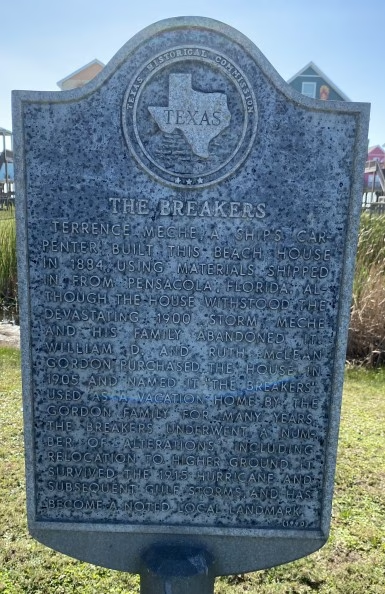
Rollover Fish Pass Historical Marker: Original Rollover Fish Pass Marker
A strait approximately 200 feet wide, 5 feet deep and more than 1,600 feet long across Bolivar Peninsula – was opened in 1955 by the Texas Game and Fish Commission as part of its continuing program to perpetuate and improve the state’s fish and wildlife resources.
The commission’s purposes in constructing this pass were to introduce into East Bay sufficient quantities of sea water to increase bay water salinity, and to provide additional opportunity for travel of marine fish to and from spawning and feeding areas in the bay.
Lower salinity in East Bay was caused by the discharge of several fresh water streams into the area on the mainland side of the peninsula. This excessive fresh water not only limited the existence of marine fish but also restricted the growth of submerged vegetation, which provides nursery areas and forms the basis of the food cycle for marine life.
Creation of Rollover Fish Pass has greatly improved salt water fishing conditions for the thousands of sportsmen who flock to East Bay throughout the year.Known as Rollover long before the Texas Game and fish Commission constructed the fish pass, this site has a history steeped in legend dating back to the days of the Spaniards and continuing through the American prohibition period. According to legend, it was first called Rollover because certain early ship captains preferring to avoid contact with the customs station at Galveston would roll barrels of imorted merchandise from the gulf side of Bolivar Peninsula over to East Bay. From there the barrels were transferred to the mainland without further formality.
The same rolling procedure – in reverse – also is said to have been used for selected items of export.
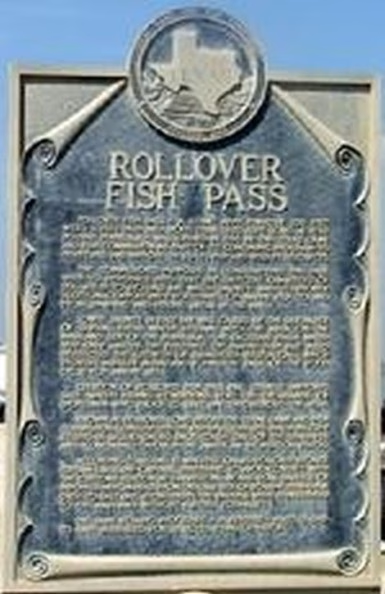
Rollover Fish Pass Historical Marker: All that remains of the marker damaged by Hurricane Ike
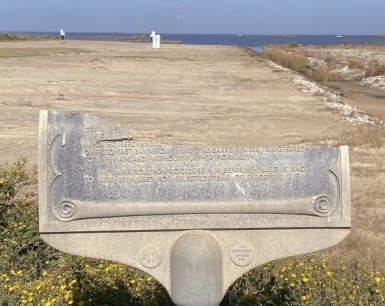
Charles Cronea Historical Marker: (January 14, 1805 – March 4, 1893) Cabin Boy in the service of Jean Laffite Buried in High Island Cemetery
Headquarters for Long’s expedition which attempted to free Texas from Spanish rule in 1819. Named in honor of Simon Bolivar (1783-1830) leader in the Spanish-American War for independence. Here Mrs. Long and a small group remained until news of her husband’s death came in 1822. A lighthouse was erected here by the Republic of Texas.
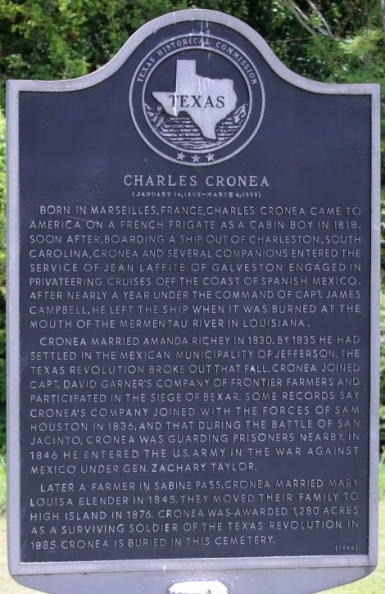
High Island Historical Marker: At the roadside park, off Hwy 124 in High Island
The coastal community of High Island sits atop a salt dome at the east end of Bolivar Peninsula. It was named High Island because the hill sits about 45 feet above sea, the only dry land visible during storms and flooding.
Settled by Anglos in the early 1800s, nearly all of High Island lies within the Martin Dunman Survey, granted in 1837. The pioneers were mostly farmers, though George E. Smith gained fame from his patented bottled water from natural springs on his land.
The town expanded in 1886 when the Gulf and Interstate Railroad began operations in the area. A depot was built, along with many new businesses. In 1897 C. T. Cade constructed the Sea View Hotel on the hill overlooking the Gulf of Mexico. The hotel became a place of refuge in 1900 and 1915 when hurricanes struck the Texas Coast, causing flooding over the peninsula.
Oil was discovered on High Island, with successful drilling beginning in 1916. Petroleum deposits found at the perimeter of the salt dome in 1931 started an oil boom, and provided employment for the region.
High Island has become recognized internationally as an important habitat for migratory birds, bringing crowds of bird-watchers annually to the area.
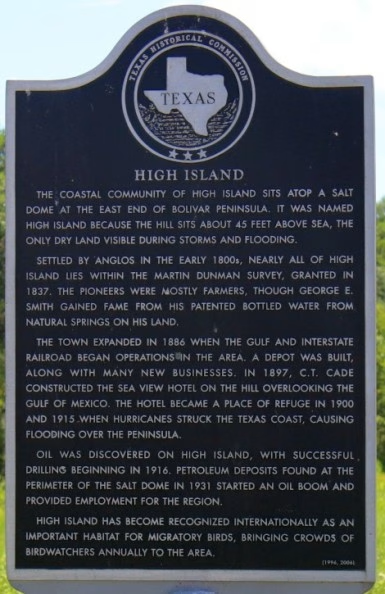
Read more about Bolivar History at the link below.




